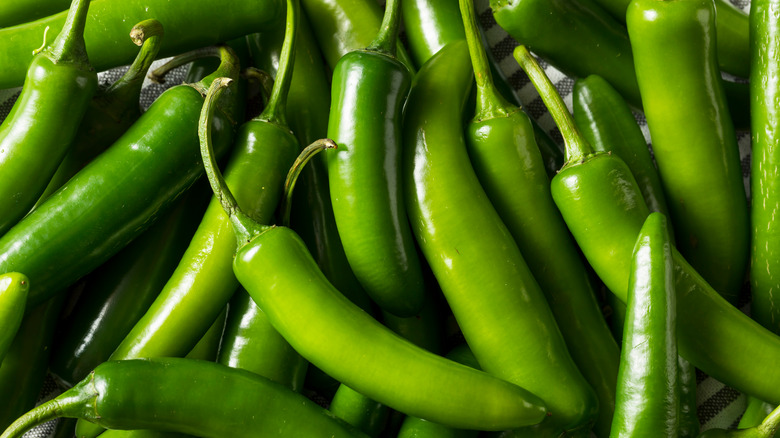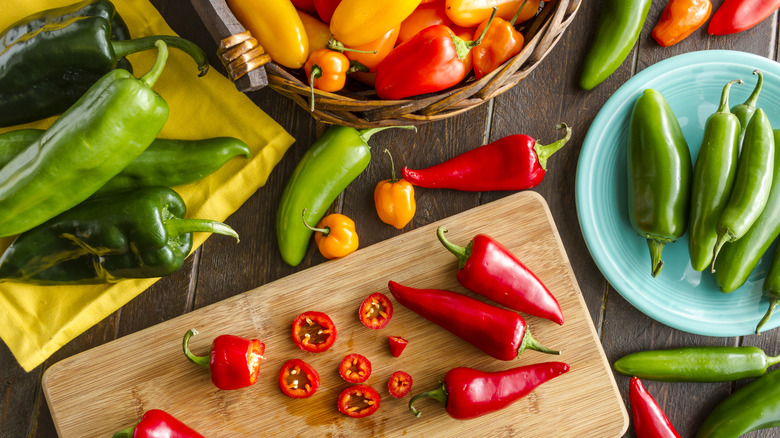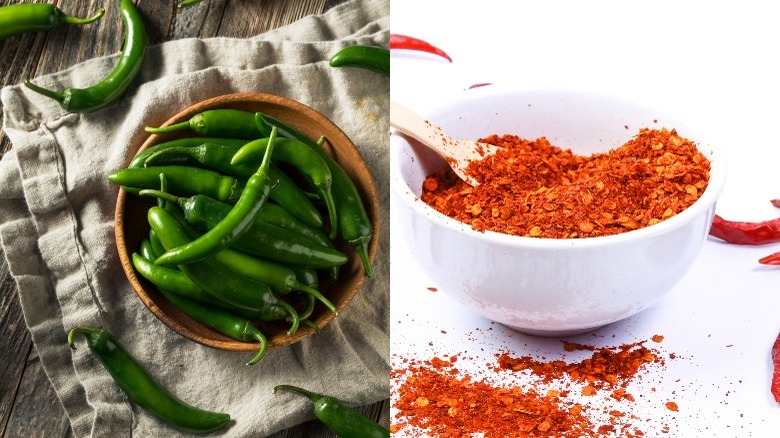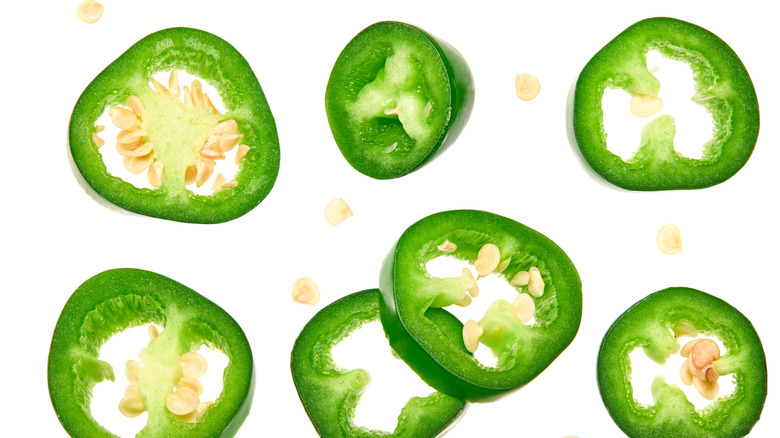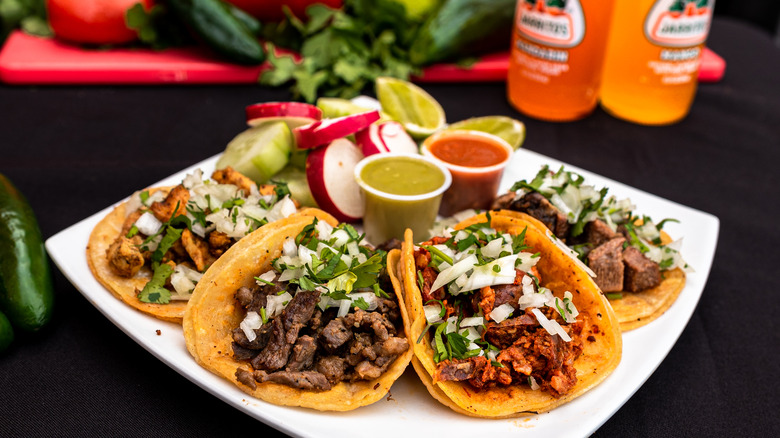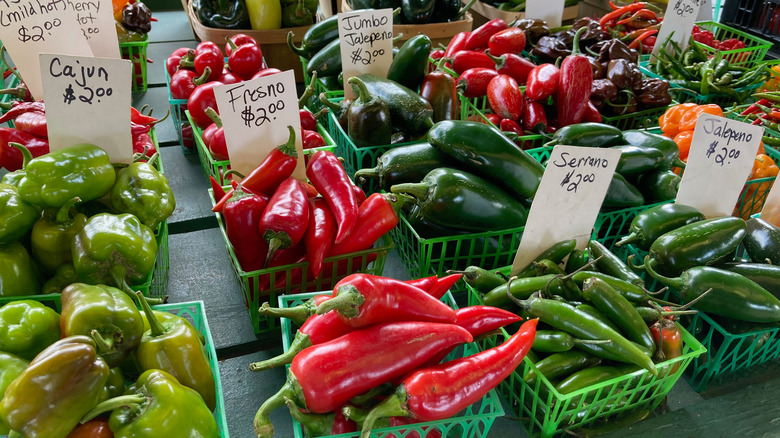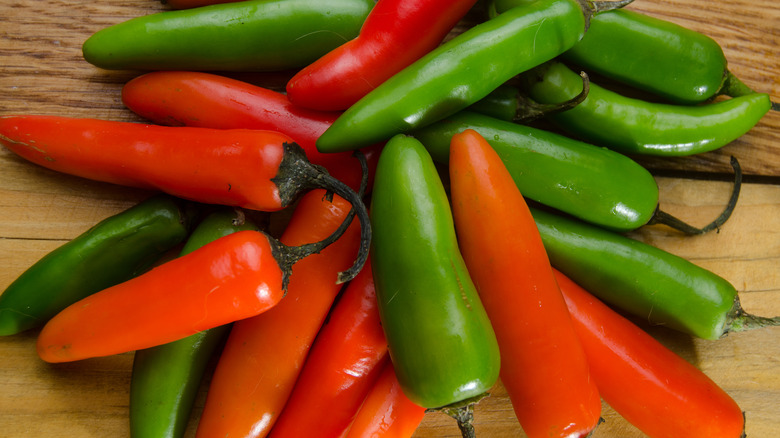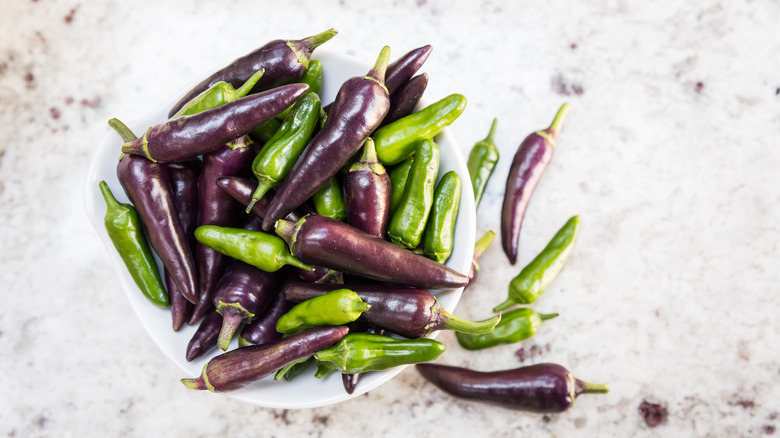What Are Serrano Peppers And How Spicy Are They?
If you enjoy a bit of extra heat in your meals, chances are you are always on the lookout for new chilis to try. The options are certainly plentiful — you've got everything from record-breaking spice levels to milder chilis that are packed with flavor, like poblanos. If they weren't yet on your radar, it's time you knew about Serrano peppers. Serranos are a cultivar of chili peppers from the Capscium annum species, according to Britannica. The species includes dozens of chili peppers as well as the milder bell pepper.
Small Axe Peppers reports that Serranos are the second most popular chili used in Mexico after jalapeños, and you can bet that they find their way into countless local recipes. Thanks to their fresh earthy characteristics and range of spiciness, Serrano peppers are incredibly versatile. They can be roasted, pickled, dried, and are regularly consumed raw. If you're accustomed to the flavor of jalapeños but are seeking a bit more heat, pick up some Serrano peppers for your next recipe.
What are Serrano peppers?
Serrano peppers are a spice-packed chili commonly used in Mexican cuisine and named after their mountainous region of origin in Mexico (via Small Axe Peppers). Serrano peppers are native to the mountains (or "sierras" in Spanish, which is where the term "Serrano" comes from) of the Puebla and Hidalgo states in Mexico. Nowadays they are found more widely across Mexico, and almost 200,000 tons are grown annually. Small Axe Peppers notes that since the 1980s, the pepper has also become more common in the United States. Aside from having a low tolerance to cold temperatures, Chili Pepper Madness reports that Serrano peppers are fairly easy to grow.
Serrano peppers are shorter, and significantly hotter than a jalapeño — about 5-10 times spicier, according to Chili Pepper Madness. The peppers can range in length from one to four inches and are about half an inch wide. Depending on their level of maturity, Serranos can be green, yellow, orange, or red at their ripest. Britannica indicates that Serrano peppers are part of the Solanaceae plant family, commonly referred to as nightshades. Other members of the nightshade family include familiar (and less spicy) fare like eggplant and tomatoes.
Fresh Serrano peppers vs. Serrano pepper powder
Fresh Serranos can be chopped up and incorporated into dishes or sauces for a spicy crunch. While they're a nice addition to many meals, their preparation and handling requires caution to avoid accidentally burning your eyes or hands. The intensity of spice can depend on the size and maturity of the pepper, per Small Axe Peppers, but it's a safe bet to assume any Serrano you encounter will pack a spicy punch.
On the other hand, powdered Serrano peppers will have a consistent heat as long as you stick to the same brand. You'll find options ranging from milder green peppers to dark red ones, with increasing levels of heat. Some powdered Serrano peppers might also be smoked before being dried and ground. Serrano pepper powder can make it easy to mix a bit of heat and flavor into any dish without having to cut any peppers first. In particular, Silk Road Spices remarks that ground Serranos work especially well when added to sauces. Alternatively, you could use the powdered spice as a dry rub, or as a finishing touch once a dish is ready to serve.
What do Serrano peppers taste like?
Serrano peppers vary in heat depending on their level of maturity, though MasterClass describes them as medium to medium hot. In terms of the Scoville scale, they range from 10,000 to 23,000 Scoville Heat Units, according to Chili Pepper Madness. While they're certainly not as spicy as habaneros, don't be fooled by their appearance. Though they look similar to milder jalapeños, they're certainly hotter — jalapeños only have around 5,000 SHUs.
Although each Serrano pepper will have a distinct level of spice, MasterClass explains that an estimate of the heat level can be made by looking at the color. The source indicates that older peppers have more time to build up capsaicin, the compound responsible for spiciness, and therefore ripe red Serranos tend to be spicier. Unlike some chilis that immediately attack with spice, Small Axe Peppers notes that the heat delivered by a Serrano pepper is more delayed.
Serrano peppers are praised for their fresh crisp flavor, which has a touch of sweetness to balance out the heat. The flavors are akin to a green bell pepper, but the spice factor is certainly unique to Serranos. Vegetal, grassy flavors are present, as well as a naturally smoky taste which is amplified if you choose to roast the pepper.
How to cook with Serrano peppers
Before you grab some Serrano peppers, be warned ー avoid any contact with your face or eyes! MasterClass recommends wearing gloves and properly cleaning any equipment that touches the peppers. If you accidentally touch your eyes, the oils in the peppers will cause a burning sensation you won't forget.
Depending on the level of spice you want to incorporate into your dish, it's a good idea to do a taste test first, since every Serrano is unique. MasterClass suggests cutting the stem off and licking the inside top part of the pepper. If it is mild, you might want to include the seeds and the white veins, which contain the most capsaicin. If you can already feel the heat rising, then you might want to stick to the fleshier parts.
You can cut Serrano peppers into small chunks, rings, or strips, and use them raw in salsas, guacamole, or salad. MasterClass suggests pairing them with fruits like pineapple to balance the flavors. Alternatively, you can pickle them, use them in relish and hot sauce, or leave them whole to roast on a barbecue. Since Serranos are fairly fleshy, Chili Pepper Madness doesn't recommend drying them.
If you're looking for inspiration to use Serranos, Mexican or Southeast Asian cuisine are good places to start. You can also substitute them for jalapeños if you want a spicier dish, or replace habaneros with Serranos for a slightly subtler heat.
Where to buy Serrano peppers
Serrano peppers aren't too obscure and you should be able to find them in the produce section of any well-stocked supermarket. For the best quality, MasterClass recommends seeking out peppers with no imperfections and firm, smooth skin. Serranos tend to ripen well in warmer weather, so it can be preferable to buy them in the summer. You're also likely to come across fresh Serranos at local farmers markets, according to Gourmet Sleuth. If you take a liking to them and want to have them on hand at any time, Chili Pepper Madness indicates that Serranos are also easy to grow.
Fresh Serranos can be kept refrigerated for a few weeks — Mexican Please recommends keeping them in a plastic bag for ideal storage. If you want to keep your peppers much longer, you can freeze or dry them for long term storage.
Aside from fresh Serrano peppers, you can purchase them dried, smoked, or ground up as powder. Keep an eye out for powdered Serrano pepper in the spice aisle, in a spice store, or through online spice retailers.
Nutritional information about Serrano peppers
Even if it might feel like your mouth is burning, chilis don't cause inflammation. In fact, the spice-delivering components of chili peppers can actually help reduce inflammation throughout the body. According to Verywell Fit, the capsaicin in Serrano peppers can reduce muscle and deep tissue pain and assist with healthy heart function.
You might not want to start crunching on raw Serrano peppers daily, but regularly incorporating them into your meals could have some advantages for your weight. A 2017 study published in Bioscience Reports observed a relationship between capsaicin consumption and weight loss. While more research is required, capsaicin appears to have a beneficial effect on metabolism.
Aside from the seriously spicy punch they pack, Serrano peppers are filled with nutrients. One cup or 100 grams of chopped peppers delivers 3.9 grams of fiber, 1.8 grams of proteins, half a gram of fat (mainly polyunsaturated), and a variety of vitamins and minerals, per Verywell Fit. According to PepperScale, you'll get 20% of your daily vitamin A needs from 100 grams of Serrano peppers and 75% of your daily vitamin C requirements. These vitamins, as well as the magnesium and iron Serranos also contain, help support red blood cell production and immune system function.
Other varieties of Serrano peppers
There are a number of varieties of Serrano peppers, all with differing sizes, colors, and intensity of spice. Serrano Long and Serrano Giant are two varieties named after visible qualities such as size (via The Chileman). Although you are likely to find just one type of Serrano pepper in the average supermarket, if you're interested in growing your own you'll have plenty of options to choose from. Depending on the climate you live in, some varieties might be better than others. Pepper Seeds also points out that certain varieties of Serranos have higher yields.
According to Pepper Seeds, some varieties of Serrano are unique, such as the Purple Serrano which ripens to be purple instead of red. It describes Space Serranos as being the hottest of the lot, indicating that there is a fair bit of variation in the level of spice. The Chileman mentions Serrano del Sol as a larger variety that ripens significantly earlier than other Serrano types.
Your options aren't limited to natural breeding, either. Chili Pepper Madness reports that the Chile Pepper Institute in New Mexico selectively bred a variety in 2019, named NuMex CaJohns Serrano. It's described as larger and milder than the standard Serrano.
